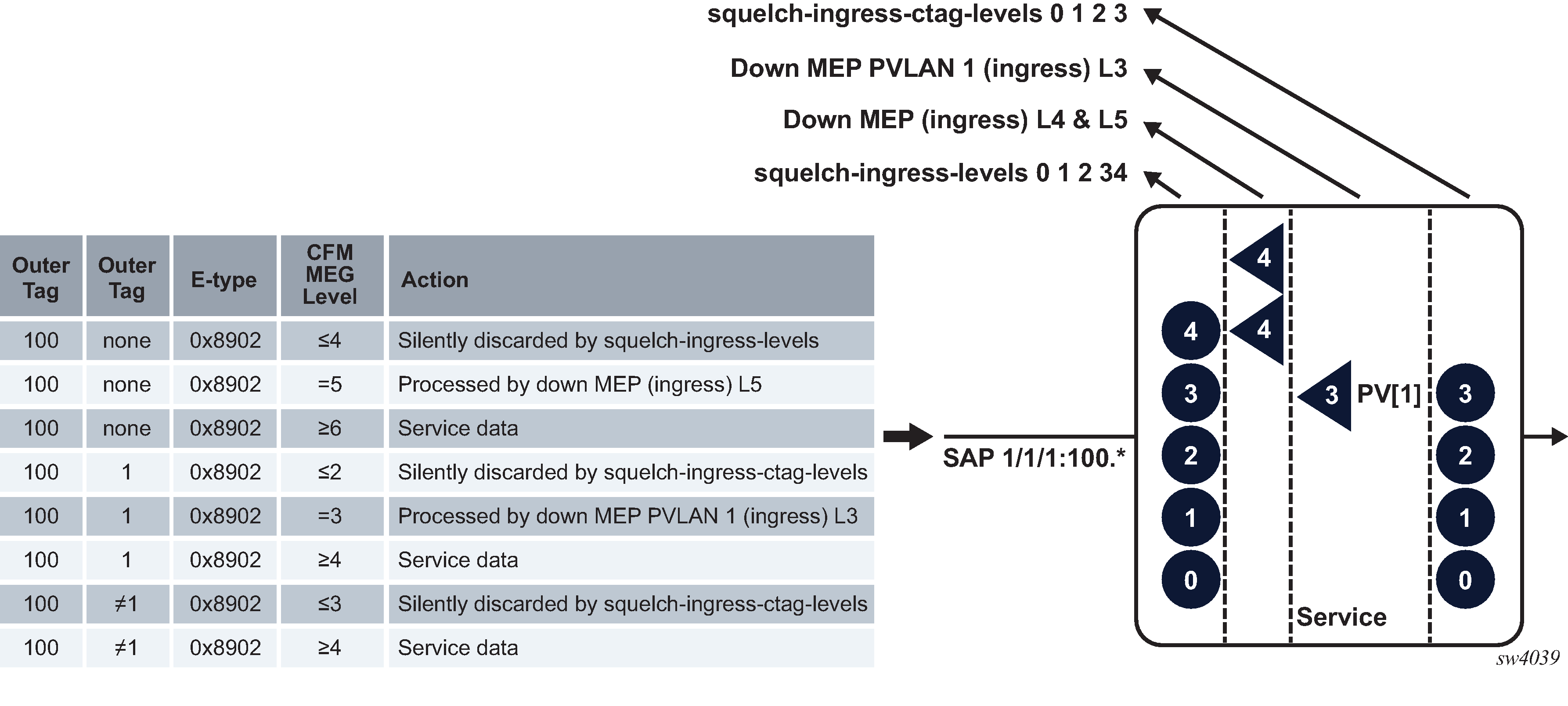The ETH-CFM architecture defines the hierarchy that supports separation of Ethernet CFM OAM domains of responsibility. Typically, encapsulation methods are used to tunnel traffic transparently through intermediate segments. Using a network topology as shown in Figure: ETH-CFM CPE to CPE, CE traffic arrives at the aggregation node and is encapsulated with a service-provider tag which hides the customer-specific tag as the packet moves through segments of the network. This method treats the ETH-CFM traffic in the same manner. The application of additional tags prevents ETH-CFM conflicts in the various Ethernet CFM OAM domains, even if the domain levels, in this case, four in this example are reused.

In some scenarios, this additional tagging principle is not displayed and this may result in conflicts and collisions. For example, as shown in Figure: ETH-CFM collision between OAM domains, an additional pair of Domain Level 4 UP MEPs are configured on the aggregation nodes. These aggregation nodes are c-tag aware. The ETH-CFM packets that are transmitted from the CE pass transparently through the passive side of the MEP (the side facing away from the ETH-CFM packet transmission) and arrive on the active side of the unintended peer MEP. This could cause a number of defect conditions to occur on the unexpectedly terminating MEP and on the unreachable MEP. For simplicity, only the direction from left CE to right side of the network is shown, although the problem exists in both directions.

These issues can be resolved through communication of ETH-CFM domain-level ownership using a business agreement. However, this communication is only a business agreement and could be violated by misconfiguration. Network-level enforcement of this agreement is important to protect both the ETH-CFM OAM domains of responsibility.
ETH-CFM ingress squelching capabilities are available to enforce the agreement and prevent unwanted ETH-CFM packets from entering a domain of responsibility that should not be exposed to ETH-CFM packets from outside its domain. Figure: Enforcement of the CFM level agreement using squelching shows the generic enforcement of the agreement using squelching. In this agreement, Domain Levels 4 and lower are reserved by the provider of the EVC. Domain Levels 5 and above are outside the EVC provider’s scope and must pass transparently through the Ethernet CFM OAM domain. The EVC provider’s boundaries are configured to enforce this agreement and silently discard all ETH-CFM packets that arrive on the ingress points of the boundary at Domain Level 4 and below.

Two different squelch functions are supported, using the squelch-ingress-levels command and the squelch-ingress-ctag-levels command.
The squelch-ingress-levels command configures an exact service delineation SAP and binding match at the ingress followed immediately by Ethernet type 0x8902. This configuration silently discards the appropriate ETH-CFM packets according to the configured levels of the command, regardless of the presence of an ingress ETH-CFM management point, MEP or MIP. This squelch function occurs before other ETH-CFM packet processing functions.
The squelch-ingress-ctag-levels command is supported for Epipe and VPLS services only. It configures an exact service delineation SAP and binding match of the ingress skipping one addition tag at the ingress, for a maximum total tag length of two tags, followed by Ethernet type 0x8902. This configuration silently discards the appropriate ETH-CFM packets according to the levels that match the configured squelch levels, if an addition tag beyond the service delineation exists. It ignores the value of the additional tag exposing that entire range to this squelch function, if there is no ingress ETH-CFM management point, MEP or MIP, at one of the configured levels covered by the squelch configuration. This squelch function is different from the option configured by squelch-ingress-levels, because it occurs after the processing of an ingress MEP or ingress MIP configured with a primary VLAN within the configured squelch levels. When a primary VLAN ingress MEP or ingress MIP is configured at a VLAN within the squelch level, that entire primary VLAN ETH-CFM function follows regular ETH-CFM primary VLAN rules. In this configuration, the ingress ETH-CFM packets that do not have an ingress MEP or ingress MIP configured for that VLAN are exposed to the squelching rules instead of the primary VLAN rules of ETH-CFM processing. In this case, ETH-CFM primary VLAN ingress processing occurs before the squelch-ingress-ctag-levels functions.
Both variants can be configured together on supported connections and within their supported services. Figure: Logical processing chain and interaction shows the logical processing chain and interaction using an ingress QinQ SAP in the form VID.* and various ingress ETH-CFM MEPs. Although not shown in the Figure: Logical processing chain and interaction, the processing rules are the same for ingress MIPs, which are ETH-LBM (loopback) and ETH-CFM-LTM (linktrace) aware.

There is no requirement to configure ingress MEPs or ingress MIPs if the goal is simply to silently discard ETH-CFM packets matching a domain level criterion. The squelch commands require contiguous levels configuration.